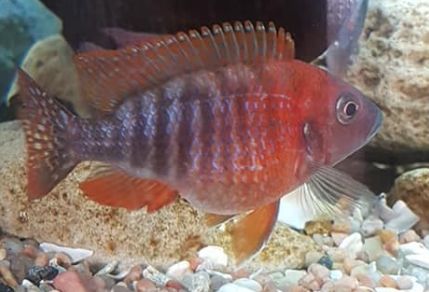
Cichlid fish from Lake Malawi in Africa (“African Cichlids”) often get very swollen in the belly. This is the infamous “Malawi Bloat”. But it should be noted that “bloat” is seen in Cichlids not from Lake Malawi.
Dropsy and Bloat
Dropsy and bloat are two conditions seen often in fish. Both mean a fish which is swollen up. The terms are sometimes used interchangeably and sometimes they have different meanings. I’ll use the following differential:

It is important to differentiate between dropsy and bloat. If one has dropsy go to this link:
11.4. Dropsy

Symptoms of Malawi Bloat
The initial symptoms of Malawi bloat are:
- The fish becomes listless and stops swimming
- The fish is not keen at feeding time
- If any food is taken in the mouth, it is spat back out again
These are the first symptoms of the diseases. What it indicates is that there is a blockage in the intestines causing food to back up.
As the diseases progress you may get:
- In advanced cases the belly swells and you get bloat
- In some cases the intestines protrude from the anus (“anal prolapse”).
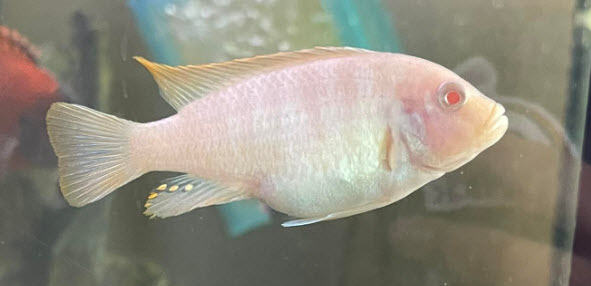
Most of the time hobbyists don’t notice a problem until the belly starts to swell. Since the diseases will be very advanced at this point treatment becomes problematic. I’ve never successfully treated a fish with the intestines sticking out. But I have successfully treated fish with just a swollen belly.
This is not just a little “constipation”. The intestines are typically quite blocked. This blockage is normally caused by the lining of the intestines becoming invaded and swelling. When the lining swells it presses inward and can block the intestine. If one cuts the fish open the infection will often (but NOT ALWAYS) be clearly visible as yellowish white sacks in the gut and surrounding the gut and the “stomach” (fish really only have a gut and no “stomach” per se).
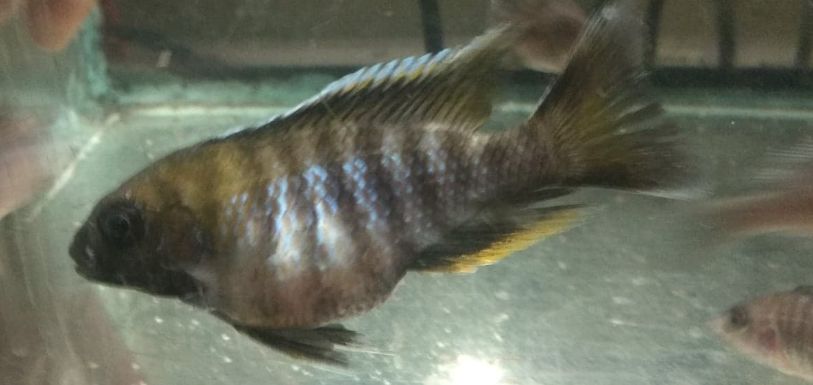
Causes of Bloat
Most African cichlids with “Malawi Bloat” have a diet high in easily digestible carbohydrates. Necropsies on dead fish with bloat show the following incidence:
- 70% have intestinal bacterial infections (treat with antibiotics and metronidazole)
- 40% have “hexamita” (treat with metronidazole and Epsom salts)
- 10% have capillaria (treat with Fenbendazole) (note this is much more common in cichlids which are NOT from Africa)
- 10% have environmental mycobacteriosis (“Fish TB” for which one can only improve the biofiltration and/or add UV sterilization)
- 10% can have cryptobia infections (there is no treatment)
There is a lot of cross over here in that the fish will have two disease organisms present. So pinning the “cause” down to one organism becomes impossible.
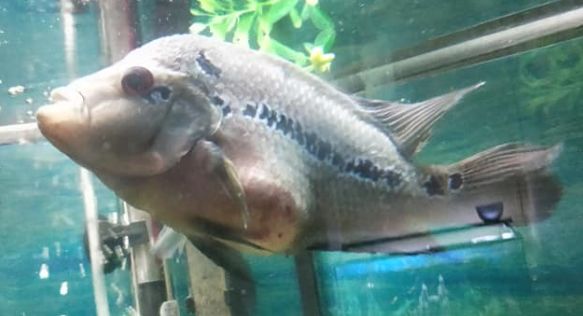
Lake Malawi Bloat and Food.
There is a very common myth that bloat in Lake Malawi cichlids is due to feeding them too much protein. This is only indirectly true. A food that is high in protein is typically low in “roughage”. And lack of roughage in the diet MAY be a contributor to the disease. To delve into this myth in more depth go to this link:
3.8. Food and Malawi Bloat
High carbohydrate diet will cause Malawi Bloat. A high carbohydrate diet (wheat, rice, corn, oats, potatoes, soybeans in flakes or pellets) causes a reaction in the gut of the cichlid which precipitates the bloat. Here a line of causation:
- There are strong indications that fish don’t digest carbohydrate (wheat, corn, rice, oats, potatoes) very well. Many university studies for aquaculture (tilapia, salmon, and catfish raising) have indicated fish only absorb roughly 50% of the carbohydrates they eat.
- If they eat flake or pellet food containing grains, corn or potatoes, large amounts of undigested carbohydrates can enter the intestines in the cichlid.
- Carbohydrates have a high “biological oxygen demand” (BOD). Meaning they remove oxygen from the fish’s intestines. So the oxygen will disappear from the gut of the cichlid. Note that proteins have a relatively low BOD.
- A flagellated single cell organism called “hexamita” (Hexamitadea spironucleus) thrives in conditions with low oxygen. The bacteria Clostridium difficile (C. diff”), also thrives in low oxygen conditions. Both pathogenic organisms are commonly found in necropsies of cichlids which have died from bloat. In addition there are a host of “undescribed” organisms which are pathogenic at low oxygen conditions.
- So the number of hexamita, C. diff. and many undescribed pathogens spiral out of control and infect the lining of the intestines.
- The lining of the intestines swells and collapses, causing a classic intestinal blockage and bloat.
Carbohydrates are the problem, not proteins, by this line of reasoning. Dixon found that high carbohydrates cause Lake Malawi Bloat by this very line of causation (“Isolation of Clostridium difficile from the African Cichlid, Nimbochromis venustus, with Malawi Bloat”, Dixon 1997).
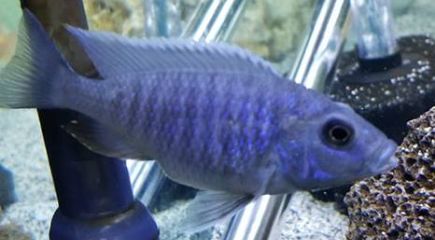
I won’t feed a food over 30% carbohydrates. Note that it takes some math to find the percentage carbohydrates. For instance a fish food might say: 35% protein, 8% ash, 8% water, 3% fiber, 8% fat. If one adds all the percentages, one get 62%. One then must subtract 62% from 100% to get 38%. The carbohydrate amount is thus 38%. This is not a food I would use as the carbohydrate content is higher than 30%.
The easy way to prevent this issue is to use food simply with at least a 45% protein content by dry weight. Such foods will not typically have over 30% carbohydrates.

Treating Bloat
Understand that easily 50% of the time a bloated fish will have something which cannot be treated. And the fish will die. But I have successfully treated many Malawi cichlids with bloat. Note I have probably 500 Lake Malawi cichlids on a very high protein low carbohydrate diet and I haven’t seen a case of bloat in years.
To treat bloat make a special food. Make a concentrated solution of Epsom salts (magnesium sulfate) (takes time to dissolve), one tablespoon in a quarter cup of water. Better yet buy magnesium citrate solution from your local pharmacy (it’s like Epsom salts, a magnesium laxative). Buy SeaChem MetroPlex, Fenbendazole and Maracyn 2 over the internet. Or buy some alternative medication from the list below.
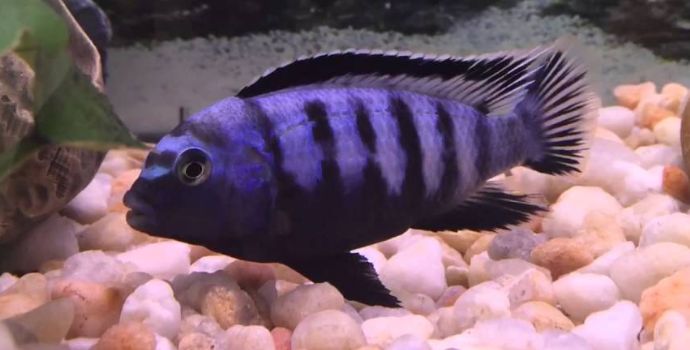
Heat the 1/4 cup magnesium solution (two ounces or 58 milliliters, not a lot) in the microwave. Then blend seven grams of plain animal derived gelatin (Knox gelatin, one packet) into the hot solution with vigorous stirring. Take two tablespoons of dry commercial fish food (pellets or flake) and mix it with just a little of the hot solution/ gelatin mixture. Add hot solution/gelatin until you get a paste like consistency. If it gets too watery just add more food.
Then add just a “smidgen” (roughly 1/16 teaspoon, a 1% to 2% addition) of medication to the mud. If you are using more than one medication mix the medications together, then use just a “smidgen” of the mixture. If you are using a packet of medication, take just a “smidgen” of the packet contents. Mix and mash the whole mass thoroughly. Spread it out into a 1/8 inch (3 mm) thick pancake on plastic film or a plate. Then put in the refrigerator. If you plan on keeping it for more than two weeks, put it in a small plastic bag and freeze.
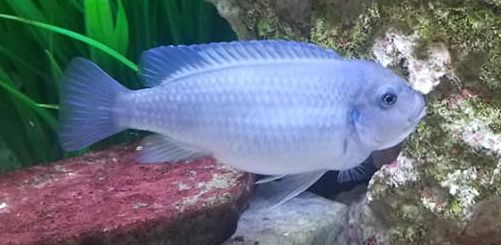
The treatment for bloat has some options:
- metronidazole, alias metro’ is in both API General Cure and SeaChem MetroPlex (both simply mixed into the food). Metro is also in Hikari Metro Plus food or New Life Spectrum Hex-Shield food. Another medication which works against hexamita is Octazin (dimetridazole). Note Fritz Aquatics Mardel Clout (Metronidazole and Trichlorfon) is no longer being sold.
- Fenbendazole is found in Safeguard for dogs, and several livestock dewormers. An alternative medication is Levamisole found on Amazon, subaquaria .com and Valleyvet .com. Levamisole is also in Agrilabs Prohibit Soluble Drench Powder and DURVET Levamed Soluble Drench Powder Dewormer. Other medications supposedly effective against roundworms are Pyrantel Pamoate, Flubendazole (Kusuri Wormer Plus) and Piperazine.
- Broad spectrum antibiotics include Midland Vet Service Aqua-Mox, VetDepot Amoxicillin, Fishbiotic Ampicillin, Mardel Maracyn 2, SeaChem KanaPlex.
In API General Cure, metronidazole is combined with praziquantel. Praziquantel kills flukes and tapeworms. Tapeworms are rarely a cause of bloat so buying General Cure is a bit of a waste. Note that these medications are not available in Europe and Canada. If you have a fish with bloat and you live in these areas you are limited to treating bloat with feeding Epsom salts in the food IF you can get the fish to eat. If the fish won’t eat try Epsom salts in the water at 100 ppm and shallow baths in saturated Epsom salts.
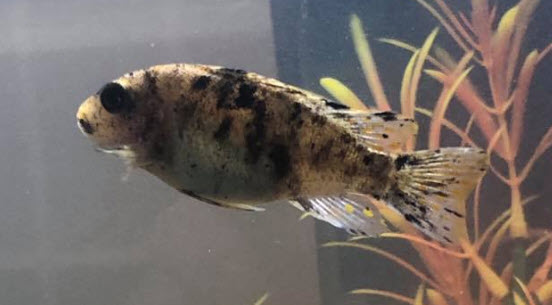
Metronidazole
Per Wikipedia:
“Metronidazole is of the nitroimidazole class. It inhibits nucleic acid synthesis by disrupting the DNA of microbial cells. This function only occurs when metronidazole is partially reduced, and because this reduction usually happens only in anaerobic bacteria and protozoans, it has relatively little effect upon human cells or aerobic bacteria.”
So, metronidazole only works in the oxygen free environment of the fish’s intestine. And fish don’t drink (we cover that completely in another section). So, adding metronidazole to the water in the aquarium does not prevent the spread of the organism to other fish It only serves to give suppliers a lot of profit. Metronidazole also won’t kill beneficial bacteria in the biofilters because the filters are well aerated.
Metronidazole is FDA approved for use in humans, so we know it is very safe and effective. There is a “myth” that metronidazole must be handled with gloves as it will poison you through the skin or cause cancer. Since metronidazole (Flagyl) is approved to be swallowed in humans to treat some bacterial and protozoan diseases this is obviously very inaccurate.
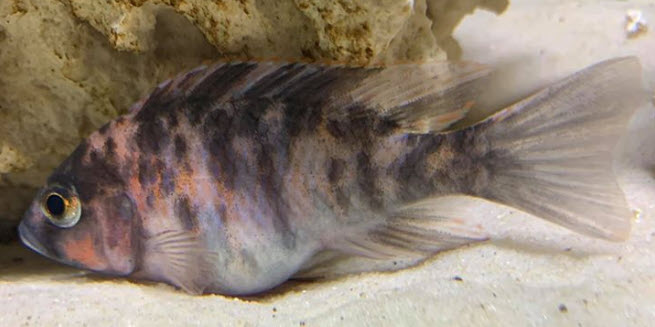
Epsom Salts
Epsom salts in the food are a well-established treatment for bloat and hexamita. Per the research paper: “Treatment of Diplomonad Intestinal Parasites with Magnesium Sulphate at a Commercial Rainbow Trout Facility”, St-Hilaire et. al.:
“Rainbow trout (average weight of 2 g) in fresh water experienced high mortality and were infected with a diplomonad intestinal parasite. Aquariums of fish experienced an immediate reduction in mortality after an in-feed treatment with 3% Epsom salts for 2 d. Treatments had to be applied several times, but in each case, there was a similar reduction in mortality.”
Other references for this include Bamidgeh, 2005, and Noga, 1995.
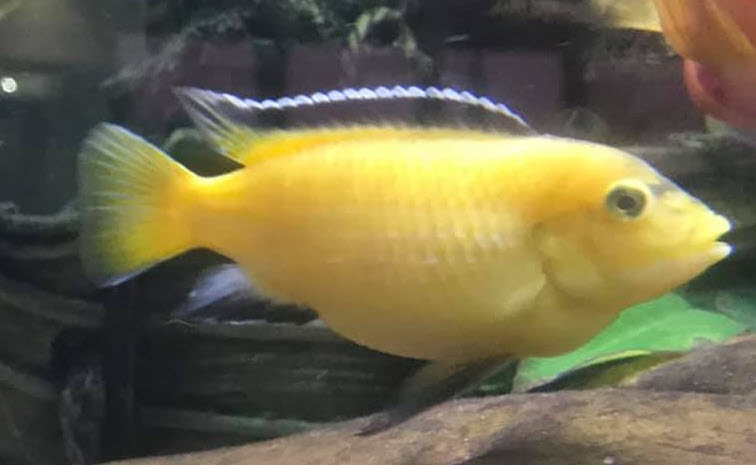
Medication Must Be in the Food
Internal fish diseases such as bloat can ONLY be treated with medications in the food. Many believe (and the instructions on the antibiotics say!) that fish medications need to be added to the water. They are simply incorrect. This controversial topic is covered in the following link:
12.5. Fish Don’t Drink
Another common combination is to have both bloat and white poop in a Lake Malawi fish, which speaks to the common genesis of both conditions:
Note metronidazole is also effective against Clostridium difficile, an opportunistic anaerobic (very low oxygen) bacterium which is sometimes found in bloat.
The fish need to be put into a hospital aquarium with a bare bottom and fed the medicated food. Sometimes fish with bloat simply won’t eat anything. There are several courses of action possible at that point. They are found in this link:
11.15. Fish Won’t Eat
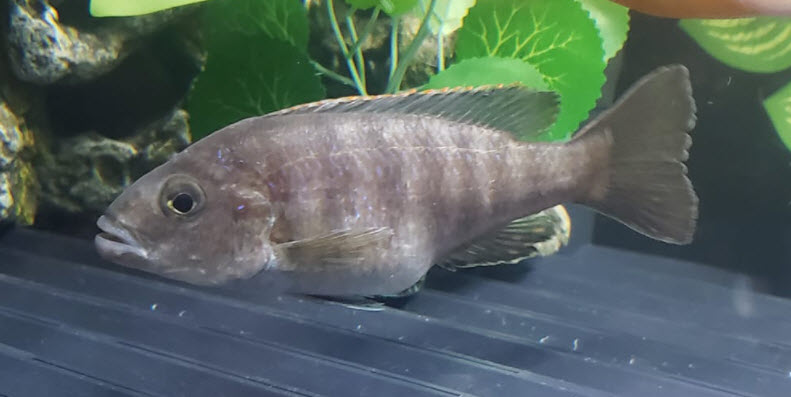
Long Term Prevention
Long term prevention of these symptoms and diseases is to feed low carbohydrate food. Because of the way fish food is labeled on must do some math to find out how much carbohydrate is in a food. Add up all the percentages. Like protein 35%, ash 8%, fiber 3%, water 8% fats 8%, all added together is 62%. Subtract 62% from 100%. You get 38%, which is the carbohydrate content. I don’t like anything higher than 30% carbohydrates.
It is also probably useful to provide roughage in the food of all cichlids, whether vegetarian, omnivore, or carnivore. This roughage can be in two forms:
- Vegetable roughage from green vegetables, algae or spirulina. Note that grains such as wheat, rice, potatoes, oats or corn have little vegetable fiber in them.
- Roughage in the form of indigestible chitin from unpeeled shrimp, mysis, krill and insect larvae (bloodworms and blackworms)

Other Pathogens
University researchers and others have found other pathogens in bloated cichlids, but the incidence is unclear:
- Clostridium difficile, an anaerobic bacterium that causes serious diarrhea in humans (“c. diff”), has been found in the intestines of some fish with bloat and “white poop” (Dixon 1997). This organism is resistant to all but metronidazole.
- Francisella bacteria can swell the fish’s spleen and cause bloat (“Francisellosis in Ornamental African Cichlids in Austria”, Lewisch, et al, 2014). Only ciprofloxacin antibiotic treats Francisella.
- Dropsy can mimic bloat. Many other bacteria such as environmental mycobacteriosis (“Fish TB”) can invade the organs and cause those organs to swell. We cover this condition in the article on “dropsy”.
11.4. Dropsy
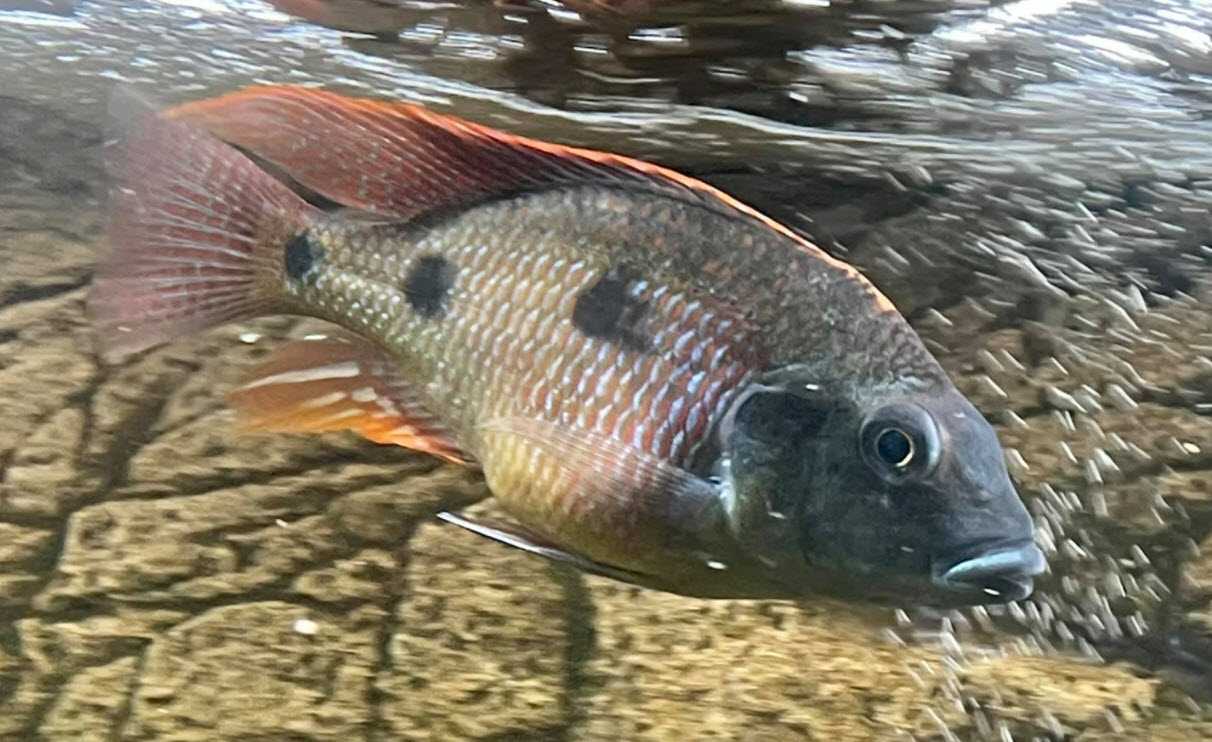
Further Reading:
The three big pathogens which cause bloat are covered in the following links:
10.5. Hexamita
10.12.2. Capillaria
10.3. Bacterial Diseases
The symptom of bloat is often accompanied by another symptom. These symptoms are covered separately in these articles:
11.2. White Poop
11.5. Sunken Belly
11.15. Fish not eating

.
Return to Symptoms Menu
.
Aquarium Science Website
The chapters shown below or on the right side in maroon lead to close to 400 articles on all aspects of keeping a freshwater aquarium. These articles have NO links to profit making sites and are thus unbiased in their recommendations, unlike all the for-profit sites you will find with Google. Bookmark and browse!
.
